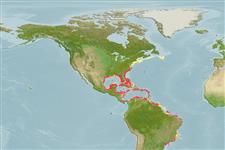Classification / Names
Common names from other countries
Main reference
Size / Weight / Age
Max length : 160 cm TL male/unsexed; (Ref. 55); common length : 90.0 cm TL male/unsexed; (Ref. 26938); max. published weight: 57.0 kg (Ref. 9710)
Environment
Marine; brackish; reef-associated; depth range 18 - 55 m (Ref. 9710)
Climate / Range
Subtropical, preferred ?; 46°N - 26°S, 98°W - 31°W (Ref. 55230)
Distribution
Western Atlantic: Nova Scotia and Bermuda (Anderson, pers. comm.) to mouths of the Amazon, Brazil. Rare north of Florida and apparently rare in the Gulf of Mexico.
Countries | FAO areas | Ecosystems | Occurrences | Introductions
Short description
Dorsal
spines
(total): 10;
Dorsal
soft rays
(total): 14;
Anal
spines: 3;
Anal
soft rays: 7 - 8. Mouth with thick lips. Preopercular notch and knob weak. Scale rows on back rising obliquely above lateral line. Back and sides pale to dark gray with a reddish tinge. The dorsal and caudal fins are grayish; the anal and pelvic fins reddish; the pectoral fins translucent or grayish.
IUCN Red List Status (Ref. 115185)
Threat to humans
Reports of ciguatera poisoning (Ref. 55)
Human uses
Fisheries: commercial; gamefish: yes
More information
ReferencesAquacultureAquaculture profileStrainsGeneticsAllele frequenciesHeritabilityDiseasesProcessingMass conversion
Tools
Special reports
Download XML
Internet sources
Estimates of some properties based on models
Phylogenetic diversity index
PD50 = 0.5000 many relatives (e.g. carps) 0.5 - 2.0 few relatives (e.g. lungfishes)
Trophic Level
4.4 ±0.5 se; Based on diet studies.
Resilience
Low, minimum population doubling time 4.5 - 14 years (Preliminary K or Fecundity.)
Vulnerability
High vulnerability (65 of 100)
Price category
